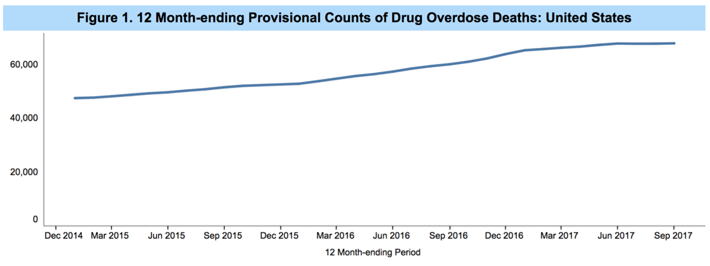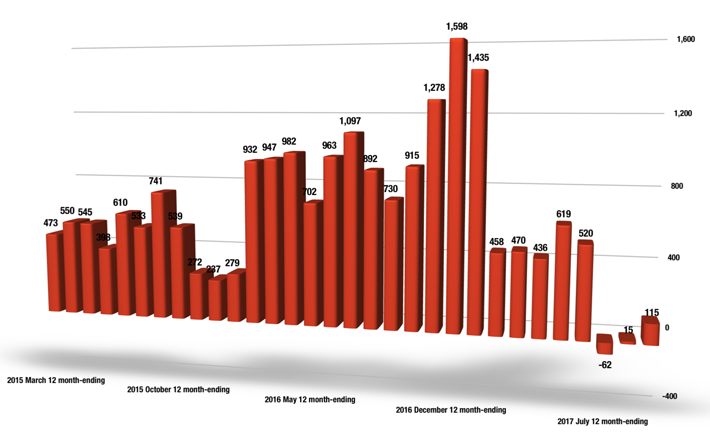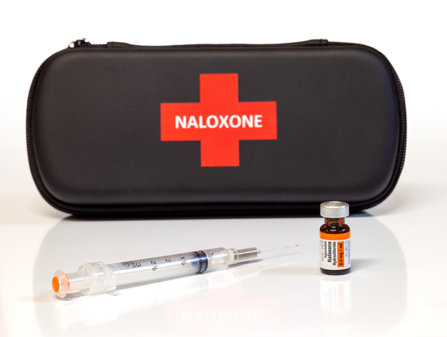Why this “Flat Graph” is Only Partly Good News

The Centers for Disease Control and Prevention in Atlanta, Georgia maintains a running tally of the number of lives lost to drug overdoses in the United States. This tally runs about six months behind but provides insight into very recent changes in the number of overdose deaths. Are we still losing more of our loved ones? Has this horrible epidemic topped out and are we starting to lose fewer? Can we begin to have hope for the safety of our children, parents, friends?
Each of the points on the chart above shows the total for the prior twelve months, so the very last point on this chart would reflect the losses from the beginning of October 2016 to the end of September 2017.
You’ll see that the last few months of this chart, the line is virtually flat. That’s the good news! Everything is right about stopping the horrific increases we have been seeing for the last several years.
Now, Let’s Take a Different Look at This Data
Let’s take look at the information on this chart from another direction. Let’s work out how much the numbers went up or down every month. To clarify, what was the difference between the twelve-month period ending in March 2015 and the twelve-month period ending in April 2015? That number was 550, a significant increase to be sure.
Here’s what that whole chart looks like, revealing the staggering increases that showed up once illicit fentanyl hit the marketplace in 2016.

But you will also see how the numbers dropped off in February 2017. Thank heavens for a little respite from the steep increases! You’ll also see that there is exactly one twelve-month period in which the numbers actually went DOWN: The period ending in July 2017.
Why is It Only “Partly” Good News?
Because it’s very likely that these numbers have not gone down because more people have recovered from their addictions. Why not? Because of two changes that are making it possible to save these people’s lives, but that do not free them from the grip of drugs.

One is the widespread use of naloxone. This antidote to an opioid overdose will reverse an overdose in minutes, saving many lives. There has been vast attention given to obtaining and distributing naloxone administration devices to the areas and the individuals who need them most.
What’s the other change? The increasing number of people being maintained on either methadone or Suboxone, both addictive opioids. When used properly, these maintenance drugs can keep a person from hitting the streets to seek out heroin, oxycodone, hydrocodone, morphine or fentanyl. However, if they stop using them, they will suffer withdrawal sickness.
These two measures do save lives. Saving lives is always a good thing. But there are three things that are even better:
- Not starting to use drugs
- Stopping before you become addicted
- Recovering your sobriety so that you are no longer dependent on drugs
We have not yet hit upon a magic formula that enables us to prevent the use of drugs by youth or adults. When we do have success in this area, it’s likely to be the result of a multi-faceted approach that involves all schools, parents, churches and even businesses, all forwarding a drug-free message.
There is also little education for those people who might be in that in-between stage of using some drugs but not yet losing control of the habit. For example, the marijuana user who is just starting to dabble in a little opioid use. Or the Adderall-using student who isn’t yet a habitual user. Looking over our music, movies, and television, there are very few messages suggesting to our citizens that living a sober, productive life is safer, more enjoyable and simply more fun.
And what about the maintenance drugs? Is it right to maintain people on addictive medications like methadone or Suboxone? These medications do help people normalize their lives, get jobs and avoid overdoses. Well, that’s if they don’t abuse these drugs and don’t try to add other drugs on top of the methadone or Suboxone, flirting with overdose when they do. There are people who utilize these medications to live a better life and there are others who don’t even try.

At Narconon, we think the best way to live is being free from reliance on any addictive substances. You are then free to enjoy the honest highs and lows of life because you have access to your own true feelings, free from the effects of these drugs.


 ®
®